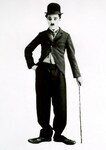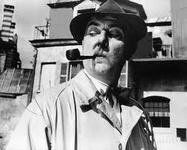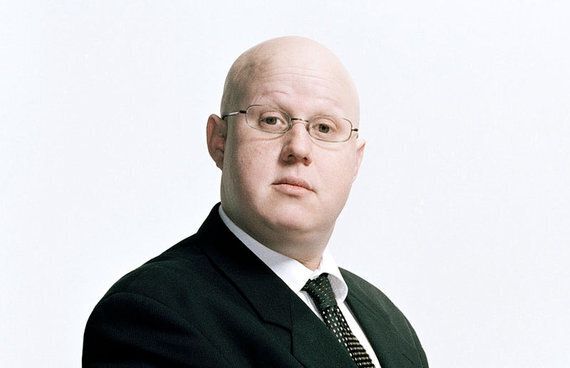With a recent episode of Reece Shearsmith and Steve Pemberton's magnificent BBC2 series Inside No.9 proving that silent comedy is far from dead, (episode two, A Quiet Night In,) and with BBC1 about to start filming a forthcoming six-part 'silent' series created by Matt Lucas, myself and Ashley Blaker (for silent read visual - there will be plenty of sound in it, just no dialogue) entitled Pompidou, - does this herald a new wave of slapstick to our TV screens?

It's never really gone away of course - though comedian Stewart Lee perhaps wishes it had. In his TV series Comedy Vehicle Lee pours scorn on slapstick by berating Del Boy's fall through the bar for being voted number one in a Funniest TV Moment clip show: "Is that really what we've come to, Britain? Del Boy falling through a bar, and Trigger making a face?!" Significantly, many of the other top clips were also sight gags - Cleese's silly walks, Dawn French collapsing into a puddle... It seems that 80 years since the advent of sound technology we still favour the sight gag over the verbal. Why?
On Easter Day in 1956 ageing comic Buster Keaton was driving through the Hollywood Hills towards Mary Pickford's mansion, Pickfair. Pickford had been one of the greatest stars of the silent era and was throwing a reunion party for everyone she'd known from those lost decades. It was a melancholy affair, full of shadows and memories, drifting butlers, a sense of lost time. But one thing Mary said to Keaton that day stuck in his mind: "It would have been more logical if silent pictures had grown out of the talkie instead of the other way round."
Her observation was astute - sound technology was not necessarily an advance in the cinematic art. It is only because silent comedy predates verbal comedy in the history of film technology that we mistakenly view spoken comedy as a progression. When sound first appeared cinema was at a peak of artistic excellence: Fritz Lang, Chaplin, Eisenstein, Keaton: then along came dialogue and suddenly camera and actor were bolted ruthlessly to the floor (when you next watch an early 30's movie see how no one speaks and moves at the same time). Ever since, visual comedy has been (wrongly) looked down on as a kind of idiot cousin to its successor: the very word 'slapstick' connotes a lack of sophistication - the Three Stooges, the Chuckle Brothers, Futtocks End, The Plank - we may have laughed at that kind of stuff when were kids, but well, we've grown out of it now...
But between 1949 and 1967 a French mime artist called Jacques Tati made a sequence of four comic (near-silent) screen masterpieces - Jour de Fete, Monsieur Hulot's Holiday, Mon Oncle, and Playtime, and in so doing proved that visual comedy need not be consigned to oblivion, but could be modern, sophisticated, experimental, creative - in a word, new.

It wasn't just Tati who pushed the envelope of pantomime - Norman Wisdom (a far more subversive comic than people remember), Ernie Kovacs, Peter Sellers, Marty Feldman, Eric Sykes, Ronnie Barker, The Goodies - right up to Lee Evans, Rowan Atkinson, Rik Mayall & Ade Edmondson, Harry Hill, Vic & Bob - and now, briefly, Shearsmith and Pemberton. Dialogue-free film and TV comedy, far from being old-fashioned or childish, is still capable of being innovative and surprising. And is ripe for a comeback.
Which is why Matt Lucas, Ashley Blaker and I have created the first 'silent' TV comedy series for nearly twenty years (the last Mr. Bean TV episode was made in 1997). Laudable though Eddie Izzard's goal is to unite international audiences by performing stand-up routines in French, German (and quite possibly Swahili) - the real international language of comedy has been there all along: the sight gag. Who was the comic star of the global TV event that was the Olympic opening ceremony? Rowan Atkinson.
In the forthcoming BBC1 series - Pompidou - Matt Lucas (one of the most inventive comic actors working in the world today) portrays an archetypal loser: like Chaplin, Keaton, Laurel and Hardy and Tati before him, his character is a Beckettian clown, a 'gentleman' fallen on hard times in whose eccentric company we drift as he fills his day confronting the modern world. As the creator of some of the greatest comic pantomime on-screen in the last 10 years (one need only think of the Lou and Andy routines in Little Britain as well as the great visual sketches in that series) Matt Lucas has already joined the pantheon of internationally-acclaimed and beloved comics.

So why is Stewart Lee wrong? Well, it's quite obvious that Del Boy's fall through the bar is far more than slapstick. It is one of the most complex and richly persistent gags in world culture - the undermining of the male peacock, the crumpling of male vanity, the puncturing of the deluded male ego: in short, the perennial comedy of the mating game. The toppling of Derek Trotter as he tries to look cool is Britain's Funniest TV Moment because it is a huge, ambitious joke, not small or culturally-specific. And because it is dumb-show it will be understood and laughed at in a thousand years' time, while every single gag of every single stand-up working today will be gibberish. The sight gag will have the last laugh.
Pompidou created and written by Matt Lucas, Julian Dutton & Ashley Blaker, and produced by Charlie Hanson, will shortly be filming for broadcast on BBC 1.
Keeping Quiet: The Story of Visual Comedy in the Age of Sound, by Julian Dutton, will be published later this year.
Photos of Chaplin, Jacques Tati & Matt Lucas in the public domain: http://www.peoplequiz.com/biographies-35267